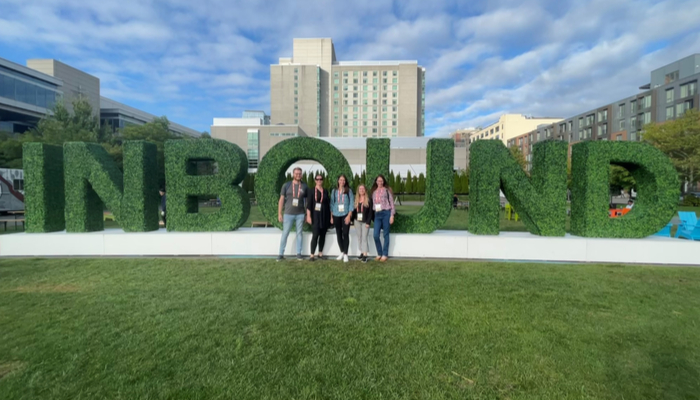As you may have seen from our recent LinkedIn post, some of the BioStrata team took a trip over to Boston MA last week to attend Inbound 2022, one of the world’s largest marketing, sales and customer service conferences. The in-person atmosphere at Inbound never fails to disappoint, so it was great for the team to be able to attend once again amongst our industry colleagues. They enjoyed networking and attending a variety of insightful talks. (Plus, the bar for keynote speaker was set incredibly high with none other than President Barack Obama!)

It's no secret that the way we live and work has changed significantly over the last few years, and it’s now more important than ever to find new ways of staying connected with our customers.
Our main takeaway this year was one that many of the talks shared, around the undeniable need for ‘community’, particularly digital communities, as a way to stay connected and share knowledge with our audiences. Communities can take many different formats from social media groups and online academies to hybrid conferences like Inbound. There is also much more of an expectation these days for brands to be transparent. This community feel combined with transparency in your content is the key to growing and maintaining trust with your customers.
The team gained lots of valuable insights at Inbound that they were keen to share on upcoming marketing trends and how to navigate through B2B marketing in today’s world. That’s why we’ve put together this blog on some of our favourite sessions and biggest takeaways. So, sit back and dive in to learn more…
.jpg?width=378&name=Inbound%20(1).jpg)
Skip ahead:
- Why PR matters in an ever-changing media landscape
- A proven formula for navigating marketing around search and social algorithms
- How to connect with your customers in a truly private era
- Three key ways to connect with your future buyers
Why PR matters in an ever-changing media landscape
In the last decade, there’s been a considerable change in the media landscape and how we consume information due to the growing impacts of the digital age, including the internet and social media.
At this year’s Inbound, we watched the live recording of an episode of the Marketing Against The Grain podcast on ‘Does PR still matter?’ hosted by Kipp Bodnar (Chief Marketing Officer at HubSpot) and Katie Burke (Chief People Officer at HubSpot). It was clear from the discussion that PR does still matter, and it’s more important than ever to understand and keep up with today’s media landscape for it to be successful.
As part of the discussion, they shared that since 2011, mobile media consumption is up 460% and desktop media consumption is up 25%. Whilst TV media consumption is down 24%, magazine media consumption is down 50% and radio media consumption is down 19% (this type of media consumption has now moved more to podcasts.) It's clear the channels that are growing are more influencer-heavy than traditional media.
In today’s world, we’re experiencing a decrease in trust and general skepticism of customer information intake. This lack of trust is not only towards the media but essentially every form of content, including branded content (particularly when it comes to important key information) and social media. As a result, companies need to build trust in their brand and are having to shift the focus of their PR strategy.

Influencer marketing is playing an ever-increasing role in helping brands build trust with customers in both the business-to-consumer (B2C) and business-to-business (B2B) media landscapes. Every market has influence, no matter how niche it may be. In each market there are people that build a name for themselves, mainly using social media platforms, by being transparent with their audiences. Utilising influencer marketing can be an accessible way to build trust for your brand. For life science marketers this could be people talking about the latest breakthrough in research in your area. Co-marketing can also be seen as a form of influencer marketing, but Katie recommends seeking out brands of a similar size to yours and working with larger companies as you grow.
Changes in the media landscape have brought about other new hurdles for the marketers and public relations professionals of today. You can no longer rely on one big outlet or publication to form your PR strategy, as the need for inclusion of niche publications is required to help build that customer trust.
Typically, an organisation’s PR strategy revolves around gaining earned media, essentially media that you don’t own. This includes engaging with reporters and publications as vehicles to build relationships and your brand. Unfortunately, the ability to build media relationships has become harder and consistency is key. Nowadays if done well, your PR strategy will encompass your owned media (your branded content and assets), which can also be used as vehicles to establish and build strong trustworthy brands that are aligned with trusted media.
How do you make PR work in a decentralised, shrinking media landscape?
First, it’s essential to understand what to expect from PR and how to balance your investment. People often underestimate the information they get from the media. Typically, when you read about news on social media, media influence is how the social channels picked up most of the stories. This information is not acknowledged as the source or reflected in media consumption data that we often see.
If you want to be the feature of a story on ‘10 reasons to use XYZ product’, you should use your owned channels such as your blog for these types of posts. Journalists do a great job of talking about how your organisation fits into a broader narrative.
One of the key reasons companies invest in PR is to help build trust and build or change perception: PR can be a huge accelerator in helping companies grow and showing investors what you do and what your brand stands for.
Companies can benefit from PR the most in the following areas:
- International growth – PR should be part of your strategy if you care about emerging markets and are looking to expand internationally. PR can help put your company on the map.
- General reputation – Your brand and customer trust are crucial to any business. PR can help you positively curate your reputation and build a brand that people trust.
How do you know if your PR strategy is working?
It’s no secret that PR is not the best vehicle for generating traffic to your website. According to Katie, PR strategies should focus on how you’re going to win. Having a clearly defined PR and communications with strong, core messaging helps make all your channels better. It also helps to build relationships with the media early as it's clear from the offset what the company does.
The impact of your earned media and owned media (such as social media) gets better if internally and externally everyone can easily get on the same page when it comes to talking about the company and who your target customer is. You should figure out what ‘winning’ looks like for your business and maintain quality over quantity. Essentially do fewer things better. Create the building blocks for success by being intentional about smaller hits that really matter.
Key takeaway: PR is critical to helping you build trust and perception for your brand. Adapt your PR strategy based on the ever-changing media landscape to continue building this trust with your customers.
A proven formula for navigating marketing around search and social algorithms
Marketing algorithms in search and social are getting tougher and tougher with marketers often wishing for a world without algorithms. However, a world without algorithms would mean seeing posts and content that isn’t tailored to you, and what you’d end up seeing might not be relevant for you at all. For example, imagine searching on Google for ‘dog food’ and amongst the results seeing content about ‘cat food’ because they’re both somewhat related within the ‘pet food’ category.
A life without algorithms would also prevent you from being shown related content such as ‘What’s next?’ videos that help you continue your viewing journey. Algorithms exist for a reason but there are ways to still do well and succeed in this ever-changing landscape. In fact, algorithms aren’t actually the issue. The issue is there’s no transparency with algorithms.
In his talk at this year’s Inbound on ‘How to navigate marketing around search and social algorithms’, Neil Patel (Co-founder of NP Digital) shared a simple formula for success as well as some of the ways you can combat these algorithm changes and win even with future changes that are going to be rolled out.
What is the formula for navigating marketing algorithms?
Success = Algorithm signals x (Learnings + What people can’t ignore)
.jpg?width=509&name=Inbound%20(4).jpg)
Let’s break this down piece by piece, starting with Algorithm signals…
Success = Algorithm signals x (Learnings + What people can’t ignore)
Algorithm signals are the information that these platforms are telling you. For example, Google’s data would tell you that the faster your website loads, the better. The more relevant, external websites that link to your website, the better. The more related, internal pages you link to from other related internal pages, the better.
Success = Algorithm signals x (Learnings + What people can’t ignore)
Next up, your learnings. These are how we keep evolving over time, what you learn from your own audience. For example, you will likely see in your own data that posting on your social channels at certain times creates more engagement than other times. Your data will tell you if video as a medium works well for you or if it doesn’t.
Success = Algorithm signals x (Learnings + What people can’t ignore)
Finally, what people can’t ignore are brands! You need to build your own brand and be self-reliant, not fully reliant on Google or social platform. Examples of ways you can build your brand include delivering free tools to your audience, winning awards to attract different audiences and building your own engaged community.
And that’s it, it’s as simple as that.
Whilst this handy formula will help you combat the search and social algorithms as they continue to change, Neil also shared some practical tips for navigating the algorithms as they are today which we’ve summarised below.
How to combat the marketing algorithms of today
When it comes to LinkedIn, the platform is craving content. You should focus your efforts on acquiring comments more than anything else. Within the first 4 hours of your post being live you need to have engaging comments on your posts for it to do well and even go viral. You can get these by creating a social media ring. If you are active on LinkedIn yourself by connecting and networking with people, let them know when you’re posting and simply ask them to leave a comment.
For Google, one of the largest factors in its algorithm is brand queries. When more people search for your “brand name” on Google, it shows them you have customer loyalty, and that you’re less likely to create false information or fake news (and therefore less misinformation). Releasing free tools to your audience is a great way to help drive traffic to and build your brand.
Key takeaway: Embrace the ever-changing search and social algorithms by working on building your own brand, paying attention to and learning from the information these platforms are providing you with, as well as analysing your own collected information and data.
How to connect with your customers in a truly private era
One particularly key topic at this year’s Inbound was online privacy. Online privacy has now become one of the most protected assets for those using the internet. It’s becoming an increasingly bigger trend as younger generations, who have grown up with the web, start to enter the market.
According to HubSpot, 83% of Generation Z (those born between 1997 and 2012) have said they are more likely to purchase from brands they trust and share their data. This trend coincides with ever-tightening privacy rules and cookie policies being adopted by major players. Apple recently announced that their iOS14 will give users the power to choose which apps collect their data (and which do not). Similarly, Google Chrome has announced it will now be phasing out cookie collection starting in 2023.
What does this mean for digital marketing in general?
Essentially, it means a reduction in the ability to collect third-party data. That is any information collected by an entity that doesn’t have a direct relationship with the user that the data is being collected on. It also means it might soon feel nigh-on-impossible to accurately monitor user behaviour in a way that can lead to actionable adjustments to things like user experience. However, with change comes opportunity and it’s an opportunity marketers need to grab with both hands. With a shifting focus back on first-party data collected directly by companies from its customers, and back on creating a meaningful connection with their prospects that goes far beyond open rates, page views and heatmaps, marketers can start building a solid first-party data core by developing a strong digital value exchange.
In a talk given by Parish Aggarwal (Head of Ads Measurement and Privacy at Google) on ‘The future of customer privacy’ at this year’s Inbound, they stated that 90% of Generation Z said they are willing to share their data for a good customer experience. However, they are more willing to share it with brands who show they are responsible with data and deliver real value.
One of the most important (and high-value) forms of first-party data is the type of data that is given willingly by your website visiting prospects and leads – not without them knowing. Prospects that freely provide you with their information in exchange for something of genuine value to them are going to be rewarded with a supplier or service provider that is there to help them, not sell to them – and they will know the difference.
First-party data can be used to marketing’s advantage; don’t just find ways of selling to your customers, find ways of helping them, educating them and maybe even inspiring them. If you can do that effectively, you will find that your customers come to you by sharing their information willingly – and soon cookies will simply be known in their edible form.

One particularly interesting talk at this year’s Inbound was given by Steve Cornwell (Founder and CEO of Northpass), Conor Bond (Senior Content Specialist at Crayon) and Sheila Lahar (Senior Director of Content Marketing at Crayon) on ‘Why an online academy is fundamental to grow your business at any size’. In their talk, they spoke about what it took for them to set up online academies where they were able to share educational content for their visitors. Not a blog, not a resources centre, but an academy. A place where visitors could go on short courses, and even get a certification if they wanted. This was an excellent way not only of generating traffic and leads through registrations, but also of establishing them as thought leaders in their relative spaces.
If you’re thinking about how best to adapt your approach to first-party data, aim to achieve three connection points of data for each of your prospects through transparent mediums using a journey they can choose and control. For example, create a short series of videos that helps explain a challenge that your customers are facing, with ways in which they can overcome those challenges. Remember; here the key is to be educational – the moment you start to simply pitch your technology, your audience is likely to zone out (if not done carefully and subtly).
Key takeaway: Focus on creating a genuine connection with, and experience for, your prospects and customers. This is likely to help you ride out, survive, and even thrive in a more protected, digitally private future.
Hear from BioStrata's Senior Account Manager, Ol Anscombe-Cox as he describes one of the stand-out trends he heard about at this year's Inbound 2022 conference.
Three key ways to connect with your future buyers
There are many different mediums competing for your customer's attention in today’s world. With the converging pressures from the wider socio-economic and geo-political environments outside and within organisations affecting buyers, companies are having to rethink how their brands can win share of mind, market and spend.
In an interesting talk at Inbound on ‘Connecting with future buyers: Winning mindshare to grow market share’ with Allyson Hugley (Global Director of Customer Insights at LinkedIn), she combined new concepts, frameworks, and metrics to guide brand marketers toward new ways of engaging current and future customers, buying groups and talent to achieve growth.
Let’s go through the three ways she recommends connecting with your future buyers. (Spoiler alert, we’ll give you our key takeaway for each step.)
1. Break through the pressures with content
There has been a huge increase in content since the pandemic, but a LinkedIn survey of B2B Decision Makers showed that:
- 71% of buyers say that less than half of thought leadership content they consume gives them valuable insights
- 55% would move on if it did not pique their interest within the first minute
- 81% said they prefer content that offers ideas that challenged their assumptions over something that validates their current thinking
- 71% want content to stimulate their thinking and generate new ideas
- 68% consume content to gain insight into future trends poised to impact their business.
With the increase in the amount of content and pressures on time and our ‘mindspace’, you need to understand the breakthrough point and provide content that truly gives them something new to think about, a new solution or a new model, to help them navigate the ‘new normal’.
Key takeaway: You need to raise the quality bar in content for your organisation. Make your content provocative and bring forward new ways of thinking to resonate with new and current buyers. Even if buyers aren’t currently in your market to buy, you should look to nurture them and create memorable moments or trigger points to keep your brand top of mind.
2. Category entry points
There are two types of category entry points, these are:
- Mental availability- how to stay top of mind
- Memory triggers- what situational context keeps brands top of mind
There is an average of 6.8 people within each buying committee - they all need awareness and affinity of partner brands. Focus on memories and situational awareness to stay top of mind of your current and future buyers.
The LinkedIn B2B Institute alternative funnel shows that 95% of your audience are not currently in the market to buy. They need to be nurtured and cultivated before they become one of the 5% in market in the traditional funnel. You need to have those memory triggers (sometimes emotional) to allow you to be top of mind, to come to mind when they need your solution.
Key takeaway: You need to understand the emotional triggers that are at play every day in the workplace and how you can build trust with your future buyers by helping them navigate the ‘new normal’.
3. Future buyers - new generations
By 2025, 27% of the workforce will be made up of Generation Z. Companies need to start establishing relationships with them now. They are leading the ‘great reshuffle’ (80% YoY increase in job transitions).
Beyond products and features, they pay a lot more attention to ‘how brands show up’ holistically in the world and this will affect the brands they want to work with and for. Generation Z are research heavy and will have insights into organisations, and choose those they will engage with and trust based on that full view. They are looking for consistency around corporate brand image, the customer brand and the talent brand.
Key takeaway: You need to consider the different preferences and vision of your brand for the next generation of workers to ensure engagement with them as future buyers.
Hear from BioStrata's Account Director, Jessica Grant and Senior Account Director, Jo Butler as they describe their key learnings from this year's Inbound 2022 conference.
Keep up-to-date with the latest marketing trends
If you’d like us to help you keep up-to-date with all the latest life science marketing trends of the future, sign up to our monthly email newsletter.
If you’d prefer to keep up-to-date on social media, you can follow BioStrata on LinkedIn and Twitter where we’ll post not only our latest tricks and tips but those from other experts in the industry.




